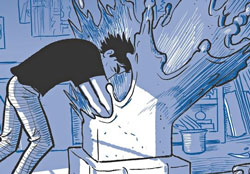Is this the sixties, or 2039?
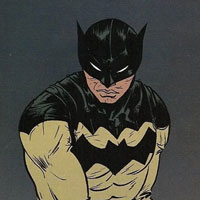 In a time without superheroes, Batman sightings are reported. But isn’t he an urban legend? Paul Pope brings his unique, inventive style to the Batman of 2039 in Batman Year 100. While new characters stand in for Robin and Oracle, is there a reason there’s no Alfred analogue? Why do Paul Pope characters have big lips? Tim and Brandon discuss this and more.
In a time without superheroes, Batman sightings are reported. But isn’t he an urban legend? Paul Pope brings his unique, inventive style to the Batman of 2039 in Batman Year 100. While new characters stand in for Robin and Oracle, is there a reason there’s no Alfred analogue? Why do Paul Pope characters have big lips? Tim and Brandon discuss this and more.
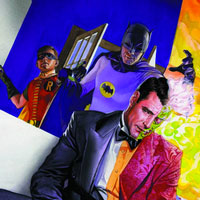 From Batman 2039, we move to Batman 1966! When production of the Adam West Batman series was gearing up, Harlan Ellison (writer of the Star Trek episode “City on the Edge of Forever”, and much else of note) submitted a treatment for an episode featuring Two-Face. While the treatment was accepted, it never made it to the script stage. Finally, in 2014, DC released a comics adaptation of this story, Batman ’66: The Lost Episode, scripted by Len Wein and drawn by Jose Luis Garcia-Lopez (cover by Alex Ross). Does it feel like the show? Who might have played Two-Face? What does this book tell us about the differences between making a TV show and making a comic? Tim and Paul slide down the Batpoles for a closer look.
From Batman 2039, we move to Batman 1966! When production of the Adam West Batman series was gearing up, Harlan Ellison (writer of the Star Trek episode “City on the Edge of Forever”, and much else of note) submitted a treatment for an episode featuring Two-Face. While the treatment was accepted, it never made it to the script stage. Finally, in 2014, DC released a comics adaptation of this story, Batman ’66: The Lost Episode, scripted by Len Wein and drawn by Jose Luis Garcia-Lopez (cover by Alex Ross). Does it feel like the show? Who might have played Two-Face? What does this book tell us about the differences between making a TV show and making a comic? Tim and Paul slide down the Batpoles for a closer look.
Podcast: Play in new window | Download
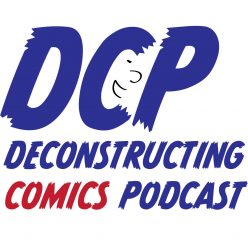

 Richard Corben has repeatedly adapted the works of Edgar Allan Poe — in fact, he’s drawn some of the same stories several times! Most recently he’s done the work collected in Dark Horse’s
Richard Corben has repeatedly adapted the works of Edgar Allan Poe — in fact, he’s drawn some of the same stories several times! Most recently he’s done the work collected in Dark Horse’s 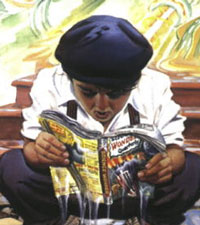
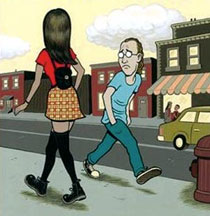 Joe Matt was one of ‘The Toronto Three’ in the 90’s; he was a no-holds barred autobiographical cartoonist who, with his friends Chester Brown and Seth, ushered in the first wave of Drawn and Quarterly work. Matt drew attention for his sense of humor as well as exposing the depraved corners of his life, including porn addiction, excessive cheapness, and an increasingly destructive relationship with his girlfriend Trish. Kumar and Koom discuss
Joe Matt was one of ‘The Toronto Three’ in the 90’s; he was a no-holds barred autobiographical cartoonist who, with his friends Chester Brown and Seth, ushered in the first wave of Drawn and Quarterly work. Matt drew attention for his sense of humor as well as exposing the depraved corners of his life, including porn addiction, excessive cheapness, and an increasingly destructive relationship with his girlfriend Trish. Kumar and Koom discuss 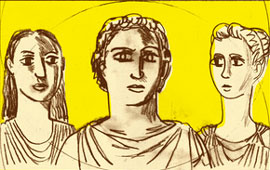 This week, an interview with Frank Santoro, who
This week, an interview with Frank Santoro, who  How would you feel if someone you went to high school with showed up on the news as a murderer? That’s what happened to the cartoonist Derf Backderf, who was acquainted with future serial killer Jeffrey Dahmer when they were teenagers in the ’70s.
How would you feel if someone you went to high school with showed up on the news as a murderer? That’s what happened to the cartoonist Derf Backderf, who was acquainted with future serial killer Jeffrey Dahmer when they were teenagers in the ’70s.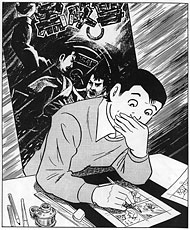 Yoshihiro Tatsumi, although he was a somewhat influential figure in the manga of the 1950s and ’60s, is largely forgotten in Japan today. However, within the past 10 years he has gained some belated fame in the West, thanks largely to the efforts of Adrian Tomine and Drawn & Quarterly.
Yoshihiro Tatsumi, although he was a somewhat influential figure in the manga of the 1950s and ’60s, is largely forgotten in Japan today. However, within the past 10 years he has gained some belated fame in the West, thanks largely to the efforts of Adrian Tomine and Drawn & Quarterly.